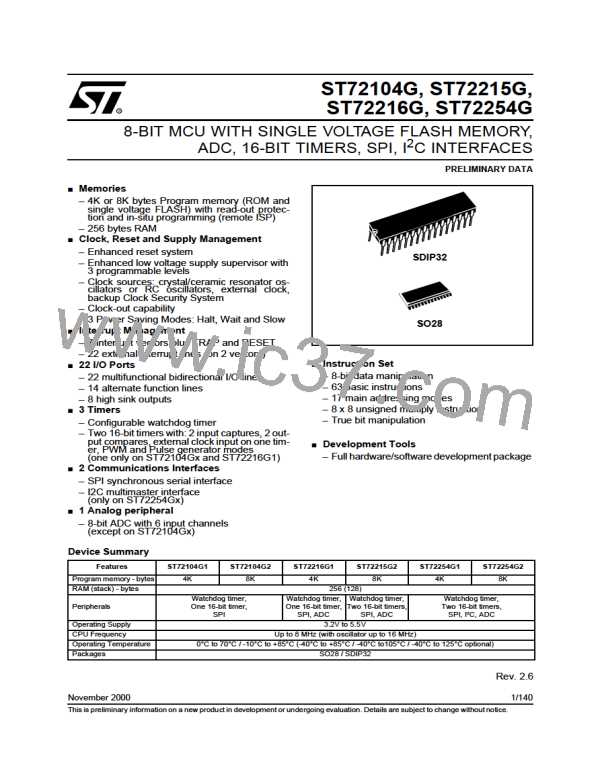ST72104G, ST72215G, ST72216G, ST72254G
16-BIT TIMER (Cont’d)
12.2.3.6 Pulse Width Modulation Mode
Pulse Width Modulation (PWM) mode enables the
generation of a signal with a frequency and pulse
length determined by the value of the OC1R and
OC2R registers.
The OCiR register value required for a specific tim-
ing application can be calculated using the follow-
ing formula:
t * f
CPU
PRESC
- 5
OCiR Value =
The Pulse Width Modulation mode uses the com-
plete Output Compare 1 function plus the OC2R
register, and so these functions cannot be used
when the PWM mode is activated.
Where:
t
= Signal or pulse period (in seconds)
= CPU clock frequency (in hertz)
f
Procedure
CPU
= Timer prescaler factor (2, 4 or 8 depend-
ing on CC[1:0] bits, see Table 13 Clock
Control Bits)
To use Pulse Width Modulation mode:
PRESC
1. Load the OC2R register with the value corre-
sponding to the period of the signal using the
formula in the opposite column.
If the timer clock is an external clock the formula is:
2. Load the OC1R register with the value corre-
sponding to the period of the pulse if OLVL1=0
and OLVL2=1, using the formula in the oppo-
site column.
OCiR = t f
-5
* EXT
Where:
t
= Signal or pulse period (in seconds)
3. Select the following in the CR1 register:
f
= External timer clock frequency (in hertz)
EXT
– Using the OLVL1 bit, select the level to be ap-
plied to the OCMP1 pin after a successful
comparison with OC1R register.
The Output Compare 2 event causes the counter
to be initialized to FFFCh (See Figure 36)
– Using the OLVL2 bit, select the level to be ap-
plied to the OCMP1 pin after a successful
comparison with OC2R register.
Notes:
1. After a write instruction to the OCiHR register,
the output compare function is inhibited until the
OCiLR register is also written.
4. Select the following in the CR2 register:
– Set OC1E bit: the OCMP1 pin is then dedicat-
ed to the output compare 1 function.
2. The OCF1 and OCF2 bits cannot be set by
hardware in PWM mode, therefore the Output
Compare interrupt is inhibited.
– Set the PWM bit.
– Select the timer clock (CC[1:0]) (see Table 13
Clock Control Bits).
3. The ICF1 bit is set by hardware when the coun-
ter reaches the OC2R value and can produce a
timer interrupt if the ICIE bit is set and the I bit is
cleared.
If OLVL1=1 and OLVL2=0, the length of the posi-
tive pulse is the difference between the OC2R and
OC1R registers.
4. In PWM mode the ICAP1 pin can not be used
to perform input capture because it is discon-
nected from the timer. The ICAP2 pin can be
used to perform input capture (ICF2 can be set
and IC2R can be loaded) but the user must
take care that the counter is reset after each
period and ICF1 can also generate an interrupt
if ICIE is set.
If OLVL1=OLVL2 a continuous signal will be seen
on the OCMP1 pin.
Pulse Width Modulation cycle
When
Counter
= OC1R
OCMP1 = OLVL1
5. When the Pulse Width Modulation (PWM) and
One Pulse mode (OPM) bits are both set, the
PWM mode is the only active one.
OCMP1 = OLVL2
When
Counter
= OC2R
Counter is reset
to FFFCh
ICF1 bit is set
53/140

 ETC [ ETC ]
ETC [ ETC ]